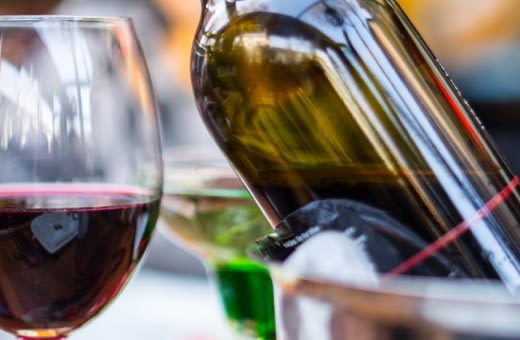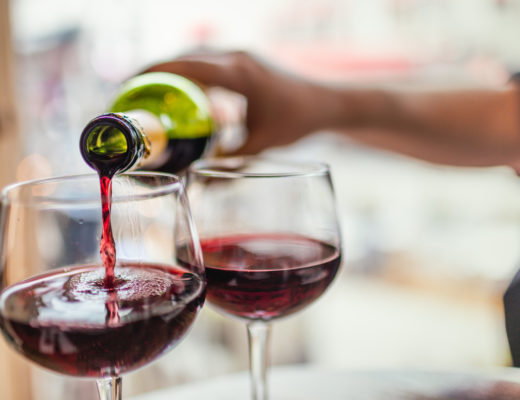With Back to School season upon us, we thought it was the perfect opportunity to take you to wine school and offer a little advice on how to become an expert wine taster.
Understanding how to fully assess wines makes drinking them so much more enjoyable.
#1. Assessing appearance
The appearance of a wine can potentially tell you a few key things—most importantly the maturity and aspects of the winemaking. It is ideally done in a well-lit environment, against a white background. Tilt the glass forward and examine the color from the center of the glass to the rim of the wine. A variation in the color between the belly of the wine and the rim is often an indication of age.
Both white and red wines change appearance as they mature. As a rule, whites become darker in color with age, turning from lemon to gold and eventually amber. In its youth, white wine can take on a golden hue if aged in oak, such as barrel-aged Chardonnay, while young unoaked whites, like Riesling, will be pale lemon in color—revealing aspects of the winemaking that can be confirmed by how youthful the wine is aromatically. Furthermore, any haziness in a white wine, outside of a few distinct styles, is a likely indicator of a flawed bottle.
Reds, on the other hand, become lighter. Most begin ruby or purple, depending on if it’s a thin-skinned variety like Pinot Noir or a thick-skinned one like Malbec, eventually fading to more garnet then tawny in color as the tannins resolve and begin to precipitate out of the wine. Called sediment, these deposits of tannins settle in the belly of the bottle over time, and can easily wind up in the glass, which is why aged reds often require decanting. Therefore, when assessing the appearance of a red wine, sediment is often a good indicator of an older bottle. A lack of clarity in a red wine is usually not an issue, often an indicator that the wine has not been fined or filtered—suggesting winemaking with the intent to create a fuller-bodied, more characterful expression.
#2 Evaluating Aromas
The aroma of a wine has a powerful effect on its nature, because the majority of taste derives from the sense of smell. First, swirl the wine in the glass to release aromatic compounds into the head space between the top of the wine and the top of the glass. Wines can range from a low intensity of aromas to pronounced, depending on the variety and winemaking. Some varieties are naturally more aromatic, such as Gewurztraminer or Pinot Noir, while others are inherently less so, like Chardonnay. Winemaking choices, such as cooler fermentation temperature or use of oak in maturation, can add to the aromatic intensity.
There are thousands of compounds in wine that lead to its aromatic complexity, but broadly speaking they can be separated into three groups. Primary aromas are the smells derived from the grapes themselves. Next come secondary aromas, which are those imparted from winemaking. Finally, tertiary aromas, or the character that results from maturation or aging in the bottle, sometimes referred to as the bouquet.
Primary aromas have a youthful, more vibrant quality, and include fresh fruits (citrus, apples, pears, peaches, tropical fruits for whites—berries, cherries, currant, plum, blue fruits for reds), flowers (lilac, rose, lavender, violet, honeysuckle, jasmine), fresh herbs and spices (mint, eucalyptus, mace, marjoram, rosemary, black pepper, white pepper, mace, anise), and earth and other aromas (forest floor, tilled earth, mineral, slate, petrol, smoke).
Secondary aromas include those from malolactic fermentation (converting the harsh malic acid into lactic acid leaving aromas of butter, yogurt, or clotted cream), oak maturation (mocha, toast, baking spice, clove, hazelnut, vanilla bean for French oak, toasted coconut, vanilla extract, dill for American oak), sur lie aging (aging the wine on its spent yeast cells, leading to aromas of nuts, biscuit, brioche, toast, flint, and cheese rind), and other aromas more commonly associated with specific wines (like walnut, Christmas cake, treacle, caramel, and coffee of an oxidatively aged wine like tawny port, raisins or sultanas in a dried grape wine like Vin Santo, burnt sugar in a maderized wine like Madeira, or olive brine aromas of a biologically aged wine like a Fino Sherry).
Tertiary aromas show the development, concentration, and interaction of primary and secondary aromas with maturation. Fruit aromas become more concentrated (dried, stewed, or confit fruits), as do floral aromas (dried, wilted, or fading flowers) and herbal and notes (dried herbs, tobacco, dry spices). Secondary aromas of winemaking become more integrated and subtle, while the wine evolves a whole another class of aromas that indicate the wine is evolving (honeycomb, toast, nuttiness in whites—leather, mushroom, truffles, and meaty aromas in reds).
A full assessment of the aromas of a wine are key to understanding its complexity and how it is developing in the bottle. When a wine displays only primary and secondary aromas, you can describe it as youthful in character—like you’d expect from a young Sauvignon Blanc. If there are a mix of tertiary aromas present along with the primary and secondary notes, you would describe the wine as developing—like you’d expect from a four to five-year-old Cabernet Sauvignon. Finally, if there are few to no primary aromas left in the wine, you would call it developed—a sign that the wine is likely past its prime
#3 Noting the Flavors
Upon tasting, first note the intensity of the flavors. Often the flavors themselves match the aromas found on the nose, but some wines show greater complexity on the palate, which is why it’s hard to judge a wine by the nose alone. Note any differences or additional flavor characteristics. Is there more pronounced fruit on the palate, or is the wine less fruity than expected from the nose? Do the oak or other aspects of winemaking stick out on the palate? Once noted, move on to assessing the structure of the wine to get a full sense of its overall quality.
#4 Understanding the Structure
There is as much to be gleaned about a wine from the structural components as the aromas and flavors: the body, acidity, alcohol, and the tannins and sweetness.
Body is the weight of the wine on your palate. This can be measured on a scale of light-medium-full. A useful way to assess this is to think about the wine like milk: Does the wine feel like skim milk, 2% milk, or whole milk? Examples of lighter-bodied wines would be Muscadet or Beaujolais- Villages while fuller-bodied wines include Condrieu or Napa Cabernet Sauvignon.
Acidity is desired in all wines, even reds. Acid can provide a backbone to wines much as tannins do and is why wine is a great pairing to food. It makes your mouth water, refreshing the palate. Sometimes, acid can be difficult for new tasters to assess. Try really swishing the wine around in your mouth before you drink (or spit) the wine, and then stop and take a moment to feel what is happening. Are you salivating strongly? Just a little? How long are you salivating? The acid can indicate a few things including where the wine was grown or the grape variety. Grapes grown in warm to hot climates (think Napa Valley or the Barossa in Australia) usually have lower acidity than those grown in cooler climates (think Chablis or the Mosel). Certain varieties also have a higher level of acidity than others. Varieties with medium to high acidity include Riesling, Sauvignon Blanc, and Pinot Noir and Sangiovese.
Tannins are polyphenolic compounds, a class of complex molecules that act as the building blocks of the grape itself, released into the wine through contact with its skins, and occasionally its stems, during the winemaking process. On the palate, tannins are a tactile sensation. They cause a drying sensation on the palate just as a strong black tea does. Some people feel them on the front of the teeth, while others feel them across the tongue. Tannins form the structural backbone of red wines, allowing them to age and provide the ability to cut through protein like a steak. They can feel very different depending on the variety and the climate of where the grapes were grown. Some descriptors can include ripe, plush, fine-grained, sandy, and grippy.
Alcohol is a byproduct of fermentation and in wine can vary from very low (think Mosel Riesling or Hunter Valley Semillon) to high (Châteauneuf-du-Pape or Amarone), but when in balance, should fit neatly into the overall package of the wine. Alcohol can be sensed as a warming sensation felt on the palate or the back of the throat. Many beginning tasters confuse alcohol and acidity on the palate. The key is to remember that acid will make the mouth water while alcohol will not.
Excluding dessert wines like Sauternes and Tokaji or fortified wines like Port and Madeira, almost all wines are dry, or at least dry enough that any residual sugar is virtually imperceptible. When present, sweetness is usually perceived at the very front of the palate and is the first sensory sensation. Sweetness can be confused with fruitiness. The key is to remember that a wine can be ripe or fruity but still be dry, and almost all table wines are dry. Some exceptions would include certain Chenin Blancs, Riesling, and Gewurztraminer; although, these can all be made in a completely dry style as well!
How these elements work together leads into the final assessment—the quality.
#5 BLICCA
BLICCA is an acronym for how wines can be assessed for quality. The thing to remember when assessing quality is to try to take out your personal taste in wine and to assess the wine for whether it has:
BALANCE
LENGTH
INTENSITY
COMPLEXITY
CONCENTRATION
AGEABILITY
Balance is the assessment of how all the structural elements of the wines are working together. A balanced wine should be like a symphony orchestra playing perfectly in tune.
Length is how long the impression of the wine lingers on your palate. One thing jutting out doesn’t count. How long do all the flavors linger together, or even get more intense as the wine develops on your palate after you have already enjoyed it?
Intensity is like the volume of the wine. Do you have to lean in to listen or does the music of the wine wash over you and inspire to play on repeat?
Complexity is an assessment of the spectrum of aromas and flavors in a wine. Are there only two descriptors you can think of or are there many words that spring to mind when smelling or tasting the wine?
Concentration describes how compact and focused the flavors and the texture of the wine is on the palate. A wine with concentration is the opposite of watery.
Ageability: all the above factors should indicate whether a wine should be able to age. Most wines aren’t meant to age and most wine is consumed within 24 hours of purchase! But for a wine you are thinking about laying down for a later date, ask yourself how it stands up to BLICCA. Stay tuned for a fun video we’re filming on this very topic!
Conclusion
This process is how a professional assesses wine to objectively determine its quality and characteristics. It can be a useful tool for fully understanding more about the wines you drink, and gaining greater enjoyment from them. However, it’s important to note that this isn’t a way to assess how much you like the wine you’re tasting. In the end, wine is intended to be enjoyed, and personal preferences play a key role. While most of us don’t professionally asses the quality of wine on a daily basis, understanding this process will greatly aid your ability to determine what you like and will help you find new and interesting wines that delight and surprise you in the future.





